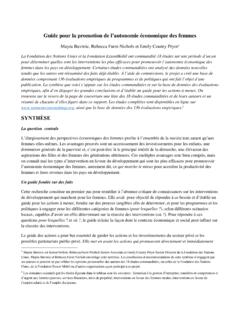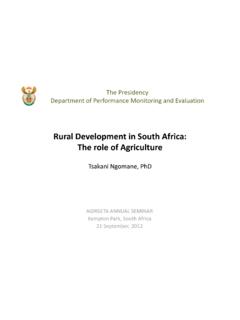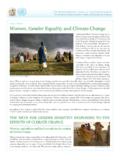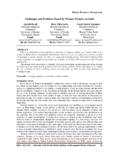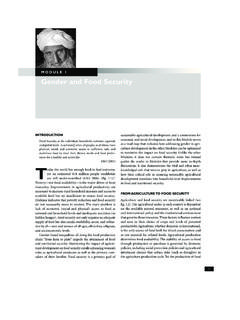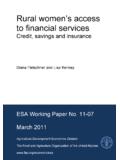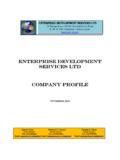Transcription of FOR PROMOTING WOMEN’S ECONOMIC EMPOWERMENT
1 A ROADMAP FOR PROMOTING women S ECONOMIC EMPOWERMENT1 Mayra Buvini is Senior Fellow; Rebecca Furst-Nichols is Senior Associate; and Emily Courey Pryor is Senior Director, all at the United Nations Foundation. Mayra Buvini and Rebecca Furst-Nichols wrote the overview. The findings and recommendations in the overview are those of these authors, and do not reflect the opinions of the individual authors of the 18 commissioned research studies, nor of the UN Foundation, the ExxonMobil Foundation or other organizations that participated in this ROADMAP FOR PROMOTING women S ECONOMIC EMPOWERMENTMAYRA BUVINI , REBECCA FURST-NICHOLS AND EMILY COUREY PRYOR1 TABLE OF CONTENTSACKNOWLEDGMENTS.
2 VIRESEARCH COMMISSIONS ..VIIFOREWORD ..VIIIACRONYMS ..IXEXECUTIVE SUMMARYThe Research Evidence-Based Research Commissions ..2 Guideposts and Ratings ..2A Roadmap for Action ..2 Priority Interventions ..3 Promising High Potential Interventions ..3 The Very Poor Need Design Implementation ..4 Addressing Knowledge Gaps ..4 Lessons .. 5 OVERVIEWS etting the Stage..12 Benefits of Equality ..12 Origins of Framework..13 Guiding Questions ..14 Types of Country Scenarios ..14 A Focus on Characteristics of Included Studies.
3 16A Roadmap for Action ..18 Ratings ..18 A Two-Step Roadmap for Action ..18 Interventions What Works for Whom ..19 What Works for Whom and (CONTINUED)Analysis and Lessons Solutions: What Works for Entrepreneurs?..27 Lessons for Entrepreneurs ..28 Farming ..37 Solutions: What Works for Farmers?..37 Lessons for Farmers ..38 Common Lessons for rural Entrepreneurs and Solutions: What Works for Wage Employees?..45 Lessons for Wage women s Solutions: What Works for Young women Workers? ..47 Conclusions ..50 Looking Addressing Knowledge Identifying Those Most Likely to Succeed.
4 52 High Potential Interventions ..52 Competent Implementation ..52 SUMMARIES OF COMMISSIONED STUDIES ..53 ANNEX A: THE CONTEXTD emographic Changes ..118 Job Scenario 1: High Fertility, Agrarian Economies ..118 Scenario 2: Declining Fertility, Urbanizing Economies ..120 Scenario 3: Declining Fertility, Formalizing Scenario 4: Aging Country Scenarios ..121 Missing Adults / Conflict-Affected Resource Rich Countries and Small Island Nations ..123 ANNEX B: COUNTRIES BY FERTILITY LEVEL ..124 ANNEX C: FEATURES OF ENABLING ENVIRONMENT.
5 126 REFERENCES ..128viACKNOWLEDGMENTSThis report has benefited from the knowledge and expertise of many individuals, all sharing a commit-ment to expanding ECONOMIC opportunities for wom -en everywhere. The United Nations Foundation and the ExxonMobil Foundation are especially grateful to the researchers who authored the eighteen commis-sioned studies. These studies provided the substan-tive information to produce the Roadmap for Action. Valuable ideas for the report were drawn at a meeting organized mid-way to discuss the draft research com-missions at the Greentree Foundation, who provided a gracious and inviting setting for these deliberations.
6 We are thankful to the researchers who participated in the session, and to Elena Bardasi, Caren Grown, Andrew Morrison, Martin Valdivia, and Dominique van de Walle who joined the meeting and provided insightful comments on the draft studies. Alaka Basu and Greta Friedmann-Sanchez gave useful comments on an early version of the report s overview. Thomas Merrick did a very thorough technical review of the full report (the overview and the summaries of the commissioned studies) and the database of em-pirical evaluations.
7 We are thankful for their time and expert feedback. The authors are indebted to our ExxonMobil Foundation colleagues, Noa Gimelli and Jim Jones. We are deeply grateful for their insights, thoughtful reviews and stead -fast leadership and support, all of which strengthened this report and our partnership. In addition to the research partners and reviewers, we wish to thank the following individuals for sharing their time and expertise: Jenny Aker, Iris Bohnet, Danielle Dukowicz, Ana Mar a Enriquez, Yassine Fall, Diane Fletschner, Henriette Kolb, Ruth Levine, Haven Ley, Luis Marquez, Martha Melesse, Chloe O Gara, Pierella Paci, Maria Pena, Claudia Piras, Josefina Posadas, Rita Ramalho, Megan Zella Rounseville, Jennefer Sebstad, Sibel Selcuk, Tara Vishwanath, and Wenchi Yu.
8 Ann Warner, Jennifer Eastes, and Patrick McCarthy carefully edited different versions of the report. Anna Wolf edited the research commission summaries. Cyn-thia Langlands and Michelle Milford Morse guided our communications and dissemination strategies, with essential contributions from our valued colleagues at APCO Leela Stake, Hannah Grill, and Parita Shah. Asha Sharma provided logistical support to the project and assisted with the report. Eighty2degrees designed the report and the Roadmap for Action.
9 Their work and contributions to the project, the report and its dissem-ination are much appreciated. Lastly, a deep sense of admiration and gratitude go to all the women whose work and effort led to the results and the stories that are showcased in the report. viviiRESEARCH COMMISSIONSThis report would not have been possible without the contributions of the research partners and authors of the research commissions, listed the Productivity and Earnings of women -Owned and/or Managed Enterprises in Developing Countries: What Works?
10 Christopher Woodruff and David McKenzieCapital, Skills and the ECONOMIC Lives of the Poor: Recent Evidence from Field ExperimentsOriana Bandiera, Robin Burgess, Selim Gulesci, Imran Rasul and Munshi SulaimanSubsistence, Transformational and Something in Between Elisa Gamberoni, Rachel Heath and Emily NixThe Benefits of women s Business Networks Vital Voices Global PartnershipWomen Who Save: A Comparative Analysis of Ecuador, Ghana and Karnataka, IndiaCheryl Doss, Carmen Diana Deere, Abena D. Oduro and Hema SwaminathanFinancial Services for Low-Income women : Opportunities for ECONOMIC EMPOWERMENT ?

